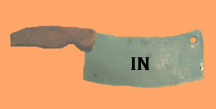Home | About | In | Out | Us | Them | Table of Contents
Pickled eggs and red beets are quite popular in my mother's hometown out in the middle of Pennsylvania, where the descendants of Eastern European immigrants and the steadfast Amish share a love of hearty, vinegary snacks. They are also quite popular in the Blue Cleaver kitchen, where we've adapted a family recipe to suit our citified tastes.

To make our pickled eggs and red beets, you will need: peeled, hard boiled eggs, white vinegar (preferably 10% acidity), bottled beet juice (optional), red beets in a jar (baby beets or slices), sliced onions, peeled cloves of garlic, sliced jalapeno peppers, and pickling spice. The amounts of each ingredient will vary according to how many eggs you want to make, how much you like pickled onions, and so forth.

Be sure to have an appropriate container on hand as well, just something big enough to hold all the eggs you want to make. We use a large mason jar because it holds a dozen eggs, it's easy to clean, and it looks nice on the table. You don't have to sterilize the container, though you can, but you must make sure it's well washed.
The simplest way to measure out your liquid is to simply fill 2/3 of your container with a blend that's 1/3 vinegar and 2/3 beet juice from the jar and from your extra bottle. If you're using vinegar with lower acidity, use a bit more; if you like your eggs less puckery, use a bit less. Water can be substituted for juice if you run out, but the eggs won't be as flavorful. This is not a science, it's an art.

Now dump that liquid blend into a pot, add pickling spices to your taste (about a tablespoon per six eggs), and simmer to boiling. When it's boiling, turn it off and cover. Fill your container with a mix of eggs, sliced onion, slightly crushed garlic cloves, and peppers to your taste. Pour the liquid into the jar and it should reach up to the lid.

Close the container and let it cool for a bit before placing in the fridge. The eggs will be pickled within a few days, and they'll get stronger with each day. After two weeks, they be getting a tad rubbery, but they won't go bad for a good long while.





